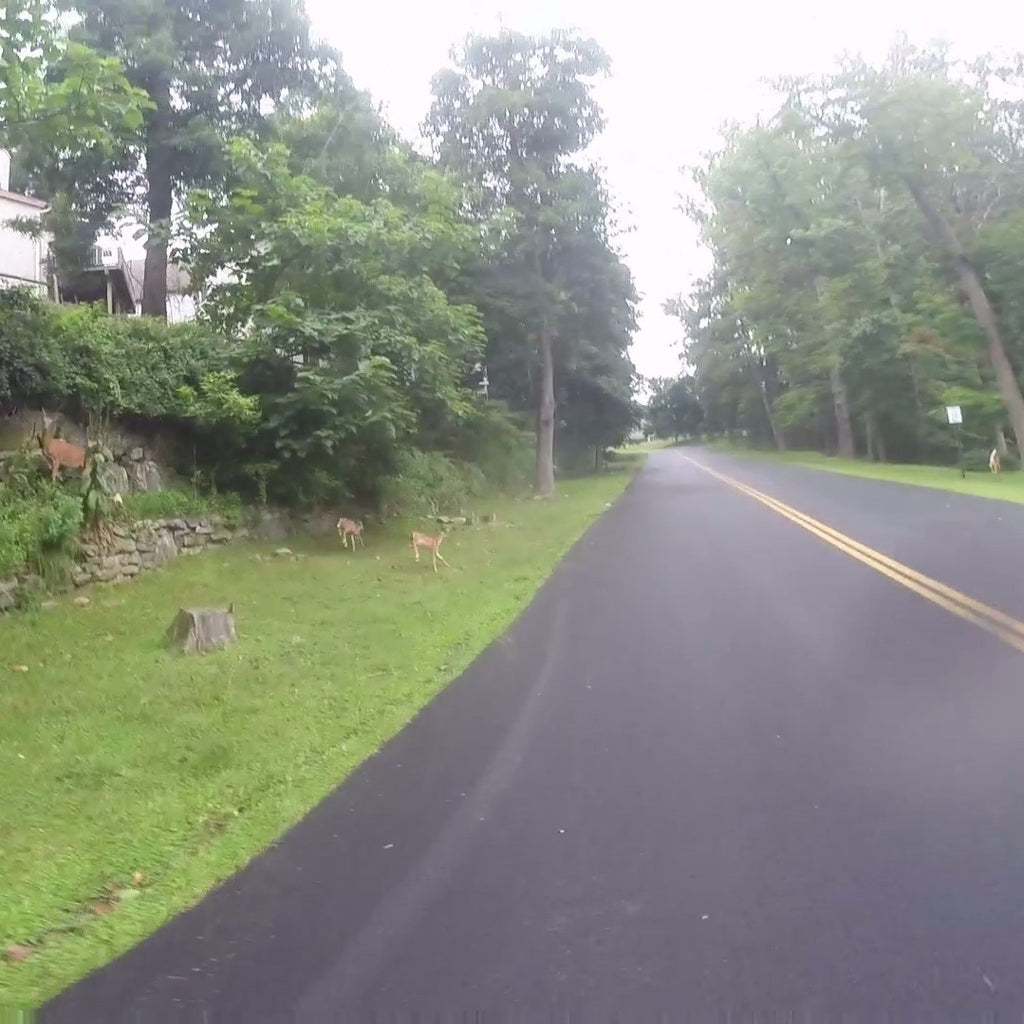The Jogging Jeweler #38

The Jogging Jeweler #38
| A Deer Dilemma |
The Jogging Jeweler typically writes about pedestrian and traffic safety, however on my most recent run was one of the most natural of surprises - a mother deer with her young....Not 1! Not 2! BUT 3 baby fawns accompanied this mother.
What does this mean?
This means their natural habit - our backyards, gardens, schools, and parks is an AMAZING & thriving environment for them. So much so that they are able to feed and provide safety for multiple offspring with each birthing season.
What is the Dilemma?
Well - much like here in the Rivertowns, back in the Midwest where I grew up deer populations, when out of control are incredibly destructive to vegetation. Farmers knowingly deduct the first 2-10 rows of any field from their harvest yields as that's how much the deer can eat.
BUT....
For us sub-urban dwellers these deer pose a much bigger threat, one that was recently demonstrate when I picked up my daughter from the sitter this past summer. An 18-month old at the sitter's was covered in marks. Had one of the kids bitten him? No. Did he have ringworm? No...He had Lymes Disease.
Deer carry ticks. They come into our gardens, yards, parks, playgrounds and the ticks fall off - bringing diseases such a Lyme, literally, to our door.
What can we do?
Four Posters - Fire Island is well-known for their approach to limiting the deer population, vegetation, and ticks carried by the deer. Fire Island has created a feeding system for the deer that is surrounded by large rollers treated with a pesticide.(Read more) When the deer insert their hungry little heads between the rollers to eat, the rollers apply a pesticide similar to Frontline for our dogs and cats to the deer, killing their existing ticks and preventing new ones from getting a free ride.
Tick Tubes - Cardboard, bio-degradable tubes, filled with cotton balls that are soaked in a synethic version of a naturally occurring tick repellent that is toxic to ticks but not mammals. Tubes are placed at homes throughout neighborhoods for mice, whom the ticks contract Lyme's from, to collect the cotton balls for nest building. Ticks then feed on the mice, ingesting the toxin and dying. Never getting the chance to free-ride on a deer and enter areas that we frequent.(Read more)
Deer birth control - They capture the deer, shoot them with birth control, release them and then dart them again in two years time to re-up the dosage. Locals can help track the immunized does via the link provided. (Read more)
Culling - They target a certain location and position a bow hunter to strike the deer dead (with hopefully one shot). Not a fan of this idea in our immediate local areas - high density population with high traffic of people, kids, vehicles, etc. (Read more)
Moving to the suburbs and dealing with nature is part of the package. Whether they are deer, skunks, coons, possums, squirrels, turkey, coyotes, woodchucks, etc. We're the smarter species, we can most certainly figure out a way to live together without killing one another ;-)
Did you know?
- Deer mate Sept-Nov, gestation lasts 7.5 months through the winter. Fawns are born May-June, hence why we are are seeing them out and about now.
- Female deer with multiples may carry off-spring from different males.
- Ticks contract Lyme's from mice, deer are the public transit for ticks.
The following is a list provided by the CDC of diseases carried by ticks:
- Anaplasmosis is transmitted to humans by tick bites primarily from the blacklegged tick (Ixodes scapularis) in the northeastern and upper midwestern U.S. and the western blacklegged tick (Ixodes pacificus) along the Pacific coast.
- Babesiosis is caused by microscopic parasites that infect red blood cells. Most human cases of babesiosis in the U.S. are caused by Babesia microti. Babesia microti is transmitted by the blacklegged tick (Ixodes scapularis) and is found primarily in the northeast and upper midwest.
- Borrelia mayonii infection has recently been described as a cause of illness in the upper midwestern United States. It has been found in blacklegged ticks (Ixodes scapularis) in Minnesota and Wisconsin. Borrelia mayonii is a new species and is the only species besides B. burgdorferi known to cause Lyme disease in North America.
- Borrelia miyamotoi infection has recently been described as a cause of illness in the U.S. It is transmitted by the blacklegged tick (Ixodes scapularis) and has a range similar to that of Lyme disease.
- Bourbon virus infection has been identified in a limited number patients in the Midwest and southern United States. At this time, we do not know if the virus might be found in other areas of the United States.
- Colorado tick fever is caused by a virus transmitted by the Rocky Mountain wood tick (Dermacentor andersoni). It occurs in the the Rocky Mountain states at elevations of 4,000 to 10,500 feet.
- Ehrlichiosis is transmitted to humans by the lone star tick (Ambylomma americanum), found primarily in the southcentral and eastern U.S.
- Heartland virus cases have been identified in the Midwestern and southern United States. Studies suggest that Lone Star ticks can transmit the virus. It is unknown if the virus may be found in other areas of the U.S.
- Lyme disease is transmitted by the blacklegged tick (Ixodes scapularis) in the northeastern U.S. and upper midwestern U.S. and the western blacklegged tick (Ixodes pacificus) along the Pacific coast.
- Powassan disease is transmitted by the blacklegged tick (Ixodes scapularis) and the groundhog tick (Ixodes cookei). Cases have been reported primarily from northeastern states and the Great Lakes region.
- Rickettsia parkeri rickettsiosis is transmitted to humans by the Gulf Coast tick (Amblyomma maculatum).
- Rocky Mountain spotted fever (RMSF) is transmitted by the American dog tick (Dermacentor variabilis), Rocky Mountain wood tick (Dermacentor andersoni), and the brown dog tick (Rhipicephalus sangunineus) in the U.S. The brown dog tick and other tick species are associated with RMSF in Central and South America.
- STARI (Southern tick-associated rash illness) is transmitted via bites from the lone star tick (Ambylomma americanum), found in the southeastern and eastern U.S.
- Tickborne relapsing fever (TBRF) is transmitted to humans through the bite of infected soft ticks. TBRF has been reported in 15 states: Arizona, California, Colorado, Idaho, Kansas, Montana, Nevada, New Mexico, Ohio, Oklahoma, Oregon, Texas, Utah, Washington, and Wyoming and is associated with sleeping in rustic cabins and vacation homes.
- Tularemia is transmitted to humans by the dog tick (Dermacentor variabilis), the wood tick (Dermacentor andersoni), and the lone star tick (Amblyomma americanum). Tularemia occurs throughout the U.S.
- 364D rickettsiosis (Rickettsia phillipi, proposed) is transmitted to humans by the Pacific Coast tick (Dermacentor occidentalis ticks). This is a new disease that has been found in California.


Comments on this post (0)